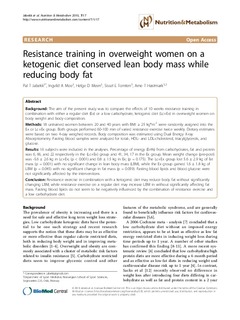| dc.contributor.author | Jåbekk, Pål | |
| dc.contributor.author | Moe, Ingvild Andreassen | |
| dc.contributor.author | Meen, Helge Dyre | |
| dc.contributor.author | Tomten, Sissel Erland | |
| dc.contributor.author | Høstmark, Arne Torbjørn | |
| dc.date.accessioned | 2010-04-30T07:17:06Z | |
| dc.date.available | 2010-04-30T07:17:06Z | |
| dc.date.issued | 2010-03-02 | |
| dc.identifier | Seksjon for idrettsmedisinske fag / Department of Sports Medicine | |
| dc.identifier.citation | Nutrition & Metabolism. 2010, 7(17) | en_US |
| dc.identifier.issn | 1743-7075 | |
| dc.identifier.uri | http://hdl.handle.net/11250/170793 | |
| dc.description | © 2010 Jabekk et al; licensee BioMed Central Ltd.
This is an Open Access article distributed under the terms of the Creative Commons Attribution License (http://creativecommons.org/licenses/by/2.0), which permits unrestricted use, distribution, and reproduction in any medium, provided the original work is properly cited. | en_US |
| dc.description.abstract | Background: The aim of the present study was to compare the effects of 10 weeks resistance training in combination with either a regular diet (Ex) or a low carbohydrate, ketogenic diet (Lc+Ex) in overweight women on body weight and body composition. Methods: 18 untrained women between 20 and 40 years with BMI ≥ 25 kg*m-2 were randomly assigned into the Ex or Lc+Ex group. Both groups performed 60-100 min of varied resistance exercise twice weekly. Dietary estimates were based on two 4-day weighed records. Body composition was estimated using Dual Energy X-ray Absorptiometry. Fasting blood samples were analyzed for total-, HDL- and LDL-cholesterol, triacylglycerols, and glucose.
Results: 16 subjects were included in the analyses. Percentage of energy (En%) from carbohydrates, fat and protein was 6, 66, and 22 respectively in the (Lc+Ex) group and 41, 34, 17 in the Ex group. Mean weight change (pre-post) was -5.6 ± 2.6 kg in Lc+Ex; (p < 0.001) and 0.8 ± 1.5 kg in Ex; (p = 0.175). The Lc+Ex group lost 5.6 ± 2.9 kg of fat mass (p = 0.001) with no significant change in lean body mass (LBM), while the Ex group gained 1.6 ± 1.8 kg of LBM (p = 0.045) with no significant change in fat mass (p = 0.059). Fasting blood lipids and blood glucose were not significantly affected by the interventions. Conclusion: Resistance exercise in combination with a ketogenic diet may reduce body fat without significantly changing LBM, while resistance exercise on a regular diet may increase LBM in without significantly affecting fat mass. Fasting blood lipids do not seem to be negatively influenced by the combination of resistance exercise and a low carbohydrate diet. | en_US |
| dc.language.iso | eng | en_US |
| dc.publisher | BioMed Central | en_US |
| dc.subject | low-carbohydrate-diet | en_US |
| dc.subject | cardiovascular risk-factors | en_US |
| dc.subject | randomized controlled trial | en_US |
| dc.subject | resting metabolic-rate | en_US |
| dc.subject | induced weight-loss | en_US |
| dc.subject | high-protein | en_US |
| dc.subject | disease risk | en_US |
| dc.subject | atherogenic dyslipidemia | en_US |
| dc.subject | caloric restriction | en_US |
| dc.subject | energy restriction | en_US |
| dc.title | Resistance training in overweight women on a ketogenic diet conserved lean body mass while reducing body fat | en_US |
| dc.type | Journal article | en_US |
| dc.type | Peer reviewed | en_US |
| dc.subject.nsi | VDP::Medical disciplines: 700::Health sciences: 800 | en_US |
